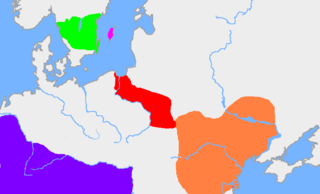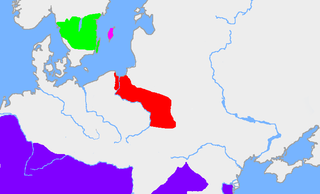
The Goths were a Germanic people who played a major role in the fall of the Western Roman Empire and the emergence of medieval Europe.

Jordanes, also written as Jordanis or Jornandes, was a 6th-century Eastern Roman bureaucrat widely believed to be of Gothic descent who became a historian later in life. Late in life he wrote two works, one on Roman history (Romana) and the other on the Goths (Getica). The latter, along with Isidore of Seville's Historia Gothorum, is one of only two extant ancient works dealing with the early history of the Goths.

The Ostrogoths were a Roman-era Germanic people. In the 5th century, they followed the Visigoths in creating one of the two great Gothic kingdoms within the Roman Empire, based upon the large Gothic populations who had settled in the Balkans in the 4th century, having crossed the Lower Danube. While the Visigoths had formed under the leadership of Alaric I, the new Ostrogothic political entity which came to rule Italy was formed in the Balkans under the influence of the Amal Dynasty, the family of Theodoric the Great.

The Rugii, Rogi or Rugians, were a Roman-era Germanic people.

De origine actibusque Getarum, commonly abbreviated Getica, written in Late Latin by Jordanes in or shortly after 551 AD, claims to be a summary of a voluminous account by Cassiodorus of the origin and history of the Gothic people, which is now lost. However, the extent to which Jordanes actually used the work of Cassiodorus is unknown. It is significant as the only remaining contemporaneous resource that gives an extended account of the origin and history of the Goths, although to what extent it should be considered history or origin mythology is a matter of dispute.
According to a tale related by Jordanes in his Getica, Gothiscandza was the first settlement area of the Goths after their migration from Scandza during the first half of the 1st century CE. He claimed that the name was still in use in his own day.

Oium was a name for Scythia, or a fertile part of it, roughly in modern Ukraine, where the Goths, under a legendary King Filimer, settled after leaving Gothiscandza, according to the Getica by Jordanes, written around 551.

Berig is a legendary king of the Goths appearing in the Getica by Jordanes. According to Jordanes, Berig led his people on three ships from Scandza (Scandinavia) to Gothiscandza. They settled and then attacked the Rugians who lived on the shore and drove them away from their homes, subsequently winning a battle against the Vandals.
The Amali – also called Amals, Amalings or Amalungs – were a leading dynasty of the Goths, a Germanic people who confronted the Roman Empire during the decline of the Western Roman Empire. They eventually became the royal house of the Ostrogoths and founded the Ostrogothic Kingdom of Italy.
The Gutones were a Germanic people who were reported by Roman era writers in the 1st and 2nd centuries to have lived in what is now Poland. The most accurate description of their location, by the geographer Ptolemy, placed them east of the Vistula river.
The War of Vesosis and Tanausis is described in Jordanes' Getica, a controversial account of the Goths as happening in remote antiquity when Vesosis, king of the Egyptians, made war against them. Their king at that time was Tanausis.

The Thervingi, Tervingi, or Teruingi were a Gothic people of the plains north of the Lower Danube and west of the Dniester River in the 3rd and the 4th centuries.

The Greuthungi were a Gothic people who lived on the Pontic steppe between the Dniester and Don rivers in what is now Ukraine, in the 3rd and the 4th centuries. They had close contacts with the Tervingi, another Gothic people, who lived west of the Dniester River. To the east of the Greuthungi, living near the Don river, were the Alans.
Vidigoia was a Thervingian Gothic warrior. His name means either "the man from the forest zone" or "the forest-barker/wolf".
The belagines were written laws which, according to Jordanes, were given to the Goths by Dicineus / Dekaineos, the Dacian-Getic legislator, Zalmoxian priest at the time of Burebista.
Vinitharius (Vinithar) was possibly a king of the Greuthungian Goths around 375-376 AD. Vinitharius is mentioned by Gothic historian Jordanes in Getica. According to him Vinitharius became the new king of the Greuthungi after the death of Ermanaric (Hermanaric). Ammianus Marcellinus reports that Ermanaric was succeeded by Vithimiris.
In medieval studies, an origo gentis is the origin story of a gens (people). It is not a literary genre of its own, but it is a part of quite extensive works that describe, for example, the history of the respective people. They can also be part of hero epics or biographies.
Arne Søby Christensen is a Danish historian. He is an associate professor in history at the University of Copenhagen.
There were several origin stories of the Gothic peoples recorded by Latin and Greek authors in late antiquity, and these are relevant not only to the study of literature, but also by historians seeking evidence of real historical events involving the Goths and other peoples mentioned in these stories.

Haliurunas, haljarunae, Haliurunnas, haliurunnae, etc., were Gothic "witches" who appear once in Getica, a 6th century work on Gothic history. The account tells that the early Goth king Filimer found witches among his people when they had settled north of the Black Sea, and that he banished them to exile. They were impregnated by unclean spirits and engendered the Huns, and the account is a precursor of later Christian traditions where wise women were alleged to have sexual intercourse and even orgies with demons and the Devil.








